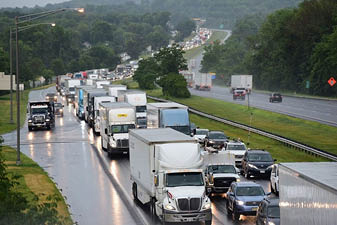|
By Dean Croke, DAT Solutions
The pandemic has altered the landscape for trucking and logistics both figuratively and literally. The “Amazon effect” has turned farmland and old industrial sites within an easy drive of urban areas into sprawling distribution centers for e-commerce fulfillment.
Take, for example, Allentown, Pa., in the Lehigh Valley. Long known for factories and steel plants, Allentown today is the most important retail freight hub in the Northeast. Nearly 30% of all American consumers live within a few hours’ drive: it’s 60 miles to Philadelphia, 90 miles to New York City, and less than 200 miles to Washington D.C.
Similar developments are multiplying outside of Chicago, Atlanta, Dallas, and Ontario, Calif., about 100 miles east of Los Angeles.
Along the way, truckload carriers have played a growing role in moving goods among these markets.
The data bears it out: the average length of haul for truckload carriers is increasing.
We looked at the number of miles between pickup and delivery by week from the beginning of 2020, before the COVID pandemic took hold, right through to the end of February 2022.
In the reefer sector, the average haul length had increased by 18% or 102 miles over that timeframe to a trip length of 610 miles. In the dry van sector, the average length of haul was much lower at 439 miles, although the increase in trip length was less than the reefer sector at 14%. In flatbed, there was not much change in the last two years, with the average trip staying around 330 miles.
While the trend toward longer hauls is driven by changes in warehouse and transportation networks, it’s also attributable to inefficiencies at ports and rail intermodal services—and the emphasis on time-definite shipping in e-commerce.
Some of these service issues are being ironed out. The backlog of container ships at the ports of Los Angeles and Long Beach has been cut in half since the beginning of the year. On the high-volume freight lane between Los Angeles and Chicago, where an estimated 30% of intermodal volume moves, truckload spot rates have plunged to almost their lowest level in 12 months.
|

Fuel prices are another factor.
Just when spot and contract truckload freight markets appeared to be falling in line with seasonal expectations, a sharp spike in diesel fuel prices injected jolt of volatility. The retail price of diesel jumped almost $1.15 a gallon as a national average during the first three weeks of March, which pushed the average fuel surcharge for dry van freight from 45 cents to almost 70 cents a mile.
Small carriers and owner-operators are highly susceptible to fuel price fluctuations. The carrier may not get paid until 30 days or more after their invoice is delivered. By then, the cost to refill the tank may have changed substantially. Carriers may also shorten trips, slow down to improve fuel economy and even park the truck for a while if they can’t negotiate rates that produce a comfortable margin.
Shippers, having focused on higher velocity in their supply chains over the last two years, are starting to prioritize utilization. Locking the doors on a half-full 53-foot trailer when fuel is $5.25 a gallon is both a waste of money and space.
Any one of these factors can affect available capacity and the distance a truck can cover.
One thing seems certain: Despite inflation and the threat of higher interest rates, people continue to shop. “Normalcy” will return to freight markets as soon as the demand for warehouses and transportation capacity catches up to the supply. Until then, expect volatility and change to be with us for the long haul.
Dean Croke is the principal industry analyst at DAT Freight & Analytics, which operates the industry’s largest marketplace for spot truckload freight and the DAT iQ business intelligence service. For information, visit dat.com.
|

